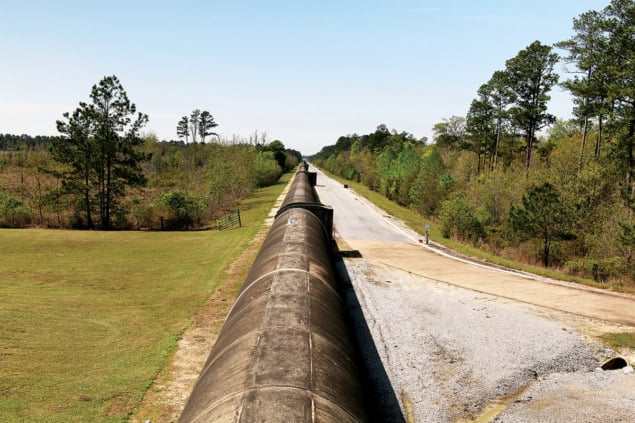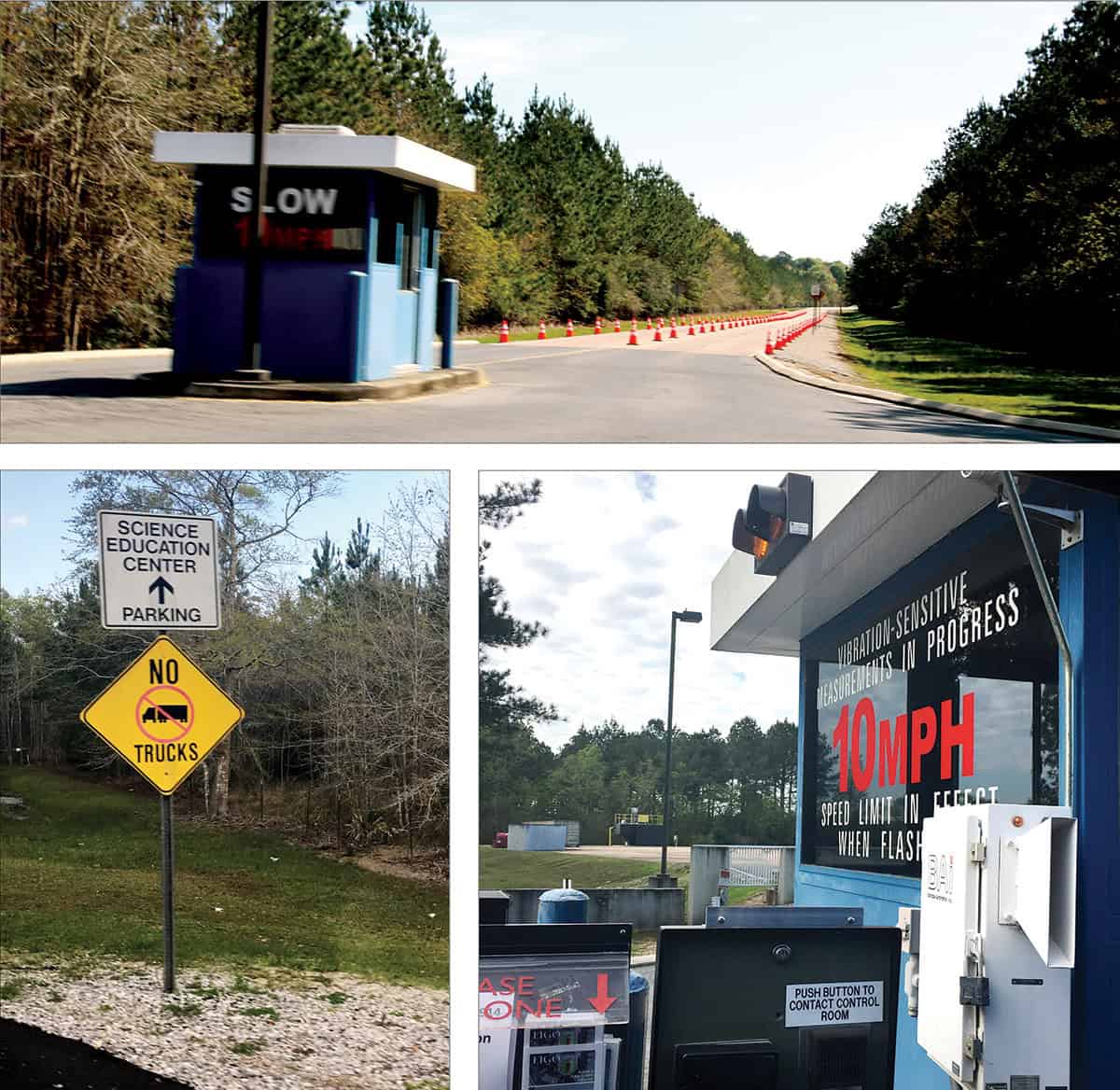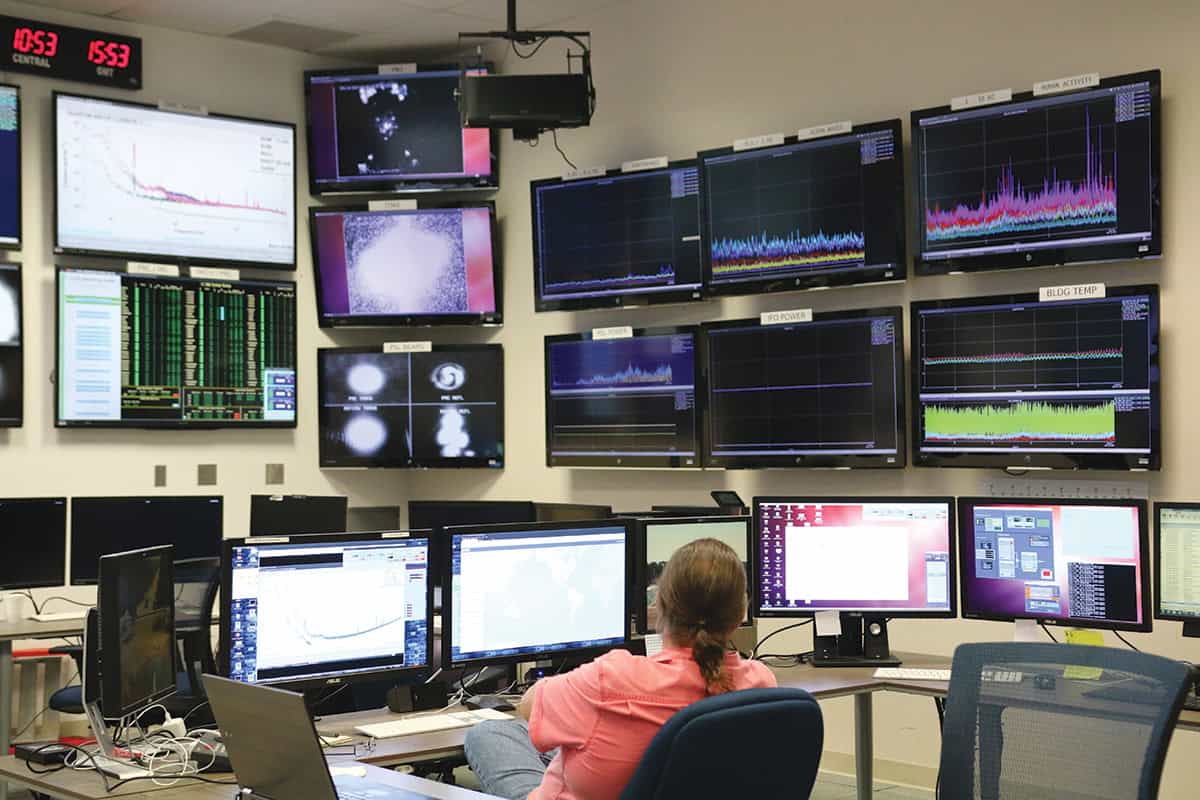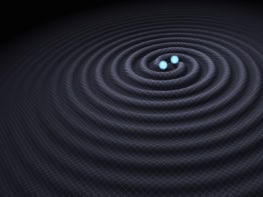Tushna Commissariat travels to the forests of Louisiana to visit the LIGO Livingston gravitational-wave observatory, where one of the most sensational discoveries of recent times was made

The road to LIGO Livingston is paved with orange traffic cones.
I’m in a taxi with my Physics World colleague Sarah Tesh, having driven up from New Orleans, where we’d been attending this year’s March meeting of the American Physical Society. We’ve turned off the main highway that links the city of Baton Rouge to the sleepy town of Livingston, and are heading along a secluded road through dense pine forest. Our destination is the sprawling Laser Interferometer Gravitational-wave Observatory (LIGO) complex, but there’s no indication that a world-class laboratory lies just around the corner.
After about eight miles, we turn off into the aptly named LIGO Lane and finally see a sign adorned with the blue-and-white LIGO Livingston logo. We’ve almost reached the site of this giant interferometer, which – along with its counterpart in Hanford, Washington – has for 15 years been silently collecting data in the search for gravitational waves, those “ripples in space–time” that Einstein first predicted. Sarah and I know we’ve finally arrived by the presence of a long row of flashing lights and traffic cones, not to mention a bold, red “10 MPH” sign and another stating: “Vibration-sensitive measurements in progress”.

The LIGO Scientific Collaboration (LSC) became front-page news last year when its members announced in February that they had finally made the first ever direct observations of gravitational waves. These were created when two black holes, of 36 and 29 solar masses, respectively, merged to form a spinning, 62-solar-mass black hole, some 1.3 billion light-years away in an event dubbed GW150914. Since then, the collaboration has detected gravitational waves from two further black-hole mergers and also bagged the 2016 Physics World Breakthrough of the Year award.
History makers
Our host for the day is Amber Stuver, a LIGO scientist and lecturer at Louisiana State University, who is now at Villanova University as an assistant professor. She greets us as we pull into the parking lot at snail’s pace, past the “no trucks” sign, and wander into the main building of one of the most amazing experiments ever built. After showing us around their children’s exhibit space – built in partnership with the Exploratorium museum in San Francisco – our first stop is the main control room for the whole Livingston site.
Every bit of desk and wall space is adorned with dozens of monitors and screens. It’s a confusing and colourful view, as half the screens are covered in data and graphs, while others stream live-feeds from different parts of the site. Stuver tells us that the detectors are gathering data as part of the second observational run, which began in November 2016, and she introduces us to the crew at hand. We meet Michael Fyffe, who is one of the lead operators, as well as LIGO staff scientist Joseph Betzwieser from the California Institute of Technology and LSC fellow Andrew Matas from the University of Minnesota.
The LSC Fellows programme includes people from all over the US, and indeed the world, who visit the site for short periods and take part in an instrumental project with a staff scientist. In addition to staff on site, LIGO also has a slew of instrumental scientists all over the world who study the machine when it is online, making notes of what can be changed or fixed during the next “commissioning phase” once the current run is over.

As we know now, the LIGO detectors were at the end of one such phase when they made their legendary first detections on 14 September 2015 – a discovery widely tipped to win a Nobel prize. Indeed, as I chat to Betzwieser – who works on the calibration of the interferometer – he tells us he was there the night before “doing some calibration measurements”, along with other colleagues who were performing “physical environmental monitoring injections”, which basically involve “taking giant speakers and blasting sound into the instrument” to see how it appears in the actual detector.
“We eventually knocked off around 4 a.m. that night and a few hours later the gravitational wave came in,” Betzwieser recalls. “So the next morning was quite interesting! But if any of us had decided to keep working past 4 a.m., we would have actually prevented the interferometer from detecting that very first event.” On such small moments, history can turn. “I was very happy that I went to sleep early that night!” Betzwieser laughs.
During a run, there is always at least one operator in the control room to fix the detector if anything goes wrong – day or night. “Many of these systems are almost completely automated, but in the end you still need a human,” says Stuver. Matas, for example, studies the LIGO site and its detectors on a daily basis, keeping remote workers abreast of the situation on the ground. He even monitors the impact of aircraft on the detectors, which are so sensitive that they can pick up the sound of a plane flying overhead, which shows up as noise in the data. The LIGO team therefore uses an array of microphones set up across the site, which record information about passing planes.
Pickin’ up bad vibrations
As we look around the room, Stuver points to an important screen that shows a live feed of the “nice Gaussian laser beam, round and bright in the middle”, which is currently bouncing around in the arms’ “resonant cavities”. She explains that the detectors’ arms are aligned such that one is half a wavelength shorter than the other, so that destructive interference occurs at the output (meaning that it is dark when there is no detection). In case of an actual observation, there are “extra photons that become statistically significant,” Stuver adds.
Suddenly, the monitors’ flag up an earthquake somewhere off the coast of Colombia. There are seismometers scattered around the entire site, as well as along the detector’s arms, making LIGO – strange though it may seem – one of the best earthquake detectors on the planet. As we pore over Fyffe’s monitor, he pulls up the latest data from the US Geological Survey (USGS) and we learn that it’s a magnitude-5.2 quake. That’s “not big enough to break lock”, but it does throw up some noticeable spikes on the wall monitor labelled “earthquakes”.

The neighbouring monitor picks up “ocean waves”, which Fyffe tells me are more of a continuous background rumble of noise – their machine is sensitive enough to constantly pick up waves in the Gulf of Mexico. Indeed, Fyffe adds that a magnitude-6 earthquake anywhere on the global sea makes “the whole earth vibrate like a bell, and we see dozens of these a week”. He recalls their detectors going “off the charts” during the devastating magnitude-7 earthquake and its many aftershocks in Haiti in 2010.
A third screen, which monitors all of the noise produced by “human activity”, is probably the busiest and also the most local. Pointing to a specific large spike on the monitor, Fyffe tells us those are the ground vibrations from our taxi pulling into the parking lot; while a much larger and longer subsequent spike was most likely thanks to a large freight train that trundled over the nearby tracks a while ago. Despite all of these seemingly unending sources of noise and disturbance, the detector is “about as best as we can get it,” says Fyffe, adding that their new suspension is good enough that it can ride out even a big earthquake.
“The system is getting so good that even if the lock does break, we are up and running again in no time,” Stuver interjects. When LIGO staff talk about the detector being on “lock”, they mean the machine being perfectly set up to take data. “All the [Fabry–Pérot] cavities are locked in alignment and the sensors are active,” explains Stuver. On a good day, it takes the team about 20 minutes to go from lock to “science mode” where they begin making observations and taking data. Most of this set-up is automated, but Fyffe adds that any odd kink in the system requires him to intervene.
Off kilter
As we chat, a small hoard of school girls from a nearby academy, who are also visiting the site, troop into the control room. They seem fascinated by the many monitors and promptly start firing questions at their teacher, who encourages them to speak to the scientists at hand instead. Soon though, there is a sudden commotion in the control room – the machine’s alignment has gone off kilter and they have lost the “lock”. The girls are ushered out as Fyffe and the others begin to assess the situation. It’s bad news for LIGO staff, but great for Sarah and me as the intervening downtime lets us walk along one of the interferometer’s two arms, which would be forbidden if the detector were running.
While a stray bullet would not badly damage the detector pipes, it would affect data-taking
Stuver ushers us into her car and we begin another slow crawl, along one of the 4 km-long arms, that are dubbed X and Y. As we drive through the pine forest, Stuver tells us that hunting is common in these parts. Indeed, one unforeseen problem in LIGO’s early days was that bullets would occasionally hit the arms as hunters chased deer and fowl through the trees. While a stray bullet would not badly damage the detector pipes, it would affect data-taking. The surrounding forest therefore has a series of elevated wooden hunting-hides that point away from the detector, thereby getting around this particular issue and allowing the locals to continue hunting.
Stuver informs us that LIGO’s civil engineers also had to take Louisiana’s 500-year floodline into consideration while creating the Livingston detector. They had to build above it, as burying the entire detector underground would have been expensive and difficult due to the high water-table. More importantly, engineers also had to correct for the curvature of the Earth, which amounts to more than one vertical metre over the 4 km length of each arm. To make sure that each arm was perfectly level along its entire length, the engineers built GPS-assisted, earth-moving, reinforced concrete floors that are up to 75 cm thick, which minimize seismic vibrations too.
X marks the spot
As we finally reach the far end of the X arm, I can’t resist stepping gingerly out of the car as even hopping on the spot – Stuver warns – would be picked up by the detector because we are so close to it. She adds that LIGO’s ultrahigh vacuum – which comprises a staggering 353,000 cubic feet (≈ 9996 cubic metres) of vacuum at 10–9 torr (1.33 × 10–7 Pa) – has never been released since it was first established in 1999, a task that took 40 days of constant pumping. During upgrades, the arms are sealed off as most of the equipment is held at either end.
LIGO staff constantly monitor the vacuum using ion pumps to extract stray gas molecules, though it’s impossible to set up a good vacuum in the end sections and the corners where most of the work is done. “So we bathe those sections holding the instruments in liquid nitrogen once we finish working there and basically freeze the arms and thereby freeze any gas molecules there,” explains Stuver, pointing to a giant, two-storey-high tank sitting just outside the building that houses the X arm’s far mirror.
Fyffe and the others in the control room have now got the detector back up and running, but they don’t know what went wrong in the first place. “These things just happen sometimes,” he shrugs, and so we head back to the main buildings where the two arms meet. This is the corner-station where the laser originates and is sent through a beamsplitter, down the two arms (see box above).
We’re just in time to meet with Brian O’Reilly, who is LIGO Livingston’s main run co-ordinator. It’s his job to ensure the detector is running smoothly, as well as co-ordinate with the sister site at Hanford. O’Reilly catches up with the operators at the end of every shift, several times a day, as well as the detector engineers. “If we get an event alert, which often happens in the middle of the night, then my phone goes off and I have to log in and join a discussion where we decide whether to share the event with electromagnetic observers,” he explains, referring to the observatories and telescopes around the world that LIGO alerts in case of an event.
How aLIGO detects gravitational waves

Following the completion of a $200m upgrade in 2015, Advanced LIGO (aLIGO) was ready to detect gravitational waves. The two observatories are essentially Fabry–Pérot interferometers consisting of two 4 km-long arms at right angles to each other, with “test masses” in the form of pure silicon primary mirrors – each weighing 40 kg and suspended as a pendulum – at both ends of the arms. Both interferometer arms are housed in an ultrahigh vacuum. The interferometers also have a “power-recycling mirror”, which can boost the laser power from 200 W to 750 kW. Despite these upgrades, even a strong gravitational-wave signal displaces a mirror by barely 10–19 m.
During a run, laser light with a wavelength of 1064 nm and a power of 20 W is sent to a beamsplitter, which transmits one half of the light into one of the arms and reflects the rest down the other arm. As each arm itself is a Fabry–Pérot cavity, the light is allowed to bounce back and forth some 400 times in each arm, effectively increasing the arm length to nearly 1600 km and thereby boosting aLIGO’s sensitivity.
After the bounces, light from each arm returns to the beamsplitter, where the two beams combine. Some of this light is again transmitted through the beamsplitter and is detected at the photodetector. If the light travels exactly the same distance down both arms, the two combining light waves interfere destructively, cancelling each other so that no light is observed at the photodetector. But if a gravitational wave slightly stretches one arm and compresses the other, the two beams would no longer completely subtract each other, producing an interference pattern at the detector. This pattern contains information about how much the two arms have lengthened or shortened, which in turn tells us about what produced the gravitational waves.
However, aLIGO does not actually measure the change in path length, which is itself affected by a passing wave. Instead, it measures tiny shifts in the period of the two beams – if the crests or troughs of the wave arrive out of synch, they produce an interference pattern, meaning that the laser actually acts as a clock and not a ruler.
On the edge
From this current run, which ended on 25 August, O’Reilly is really hoping that they pick up a neutron star event. “[That could be] either a neutron-star binary inspiral event, or a neutron star and a black hole…but I think our sensitivity is maybe at the edge of seeing something like that, so we would require a little bit of fortune,” he says. As Physics World went to press, rumours were circling that LIGO has indeed picked up one such event, but there has been no official conformation.
I ask O’Reilly about what a regular day at LIGO looks like for him, working in a wild and beautiful location, on such a big experiment. “I have young babies and they wake me up in the early hours of the morning… so I’ll typically call the operator and see how the night went. I can look online at our performance and see at a glance how things went, but I’ll call if there has been a problem and we will discuss it and see if some intervention is required.”
From all the people I’ve spoken to through the day, the highly collective nature of the entire collaboration is obvious and to me is a clear feature of their success. “I think it’s an exciting time for gravitational-wave astronomy,” says O’Reilly. “Over the next four or five years we will probably make – hopefully make – no, we will make more exciting discoveries and really set the stage for the next generation of detectors, guiding where we will look and what type of things we will see.”
As we slowly drive back up LIGO Lane, I wonder if the team members have already made any more detections, but are keeping quiet while they confirm their findings. As it happens, I was right – LIGO announced its third detection this June, having picked up the waves on 4 January. Those ripples that LIGO has been chasing after may be tiny, but the impact they are having on modern astronomy is, I am sure, going to be huge.



